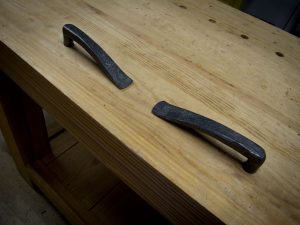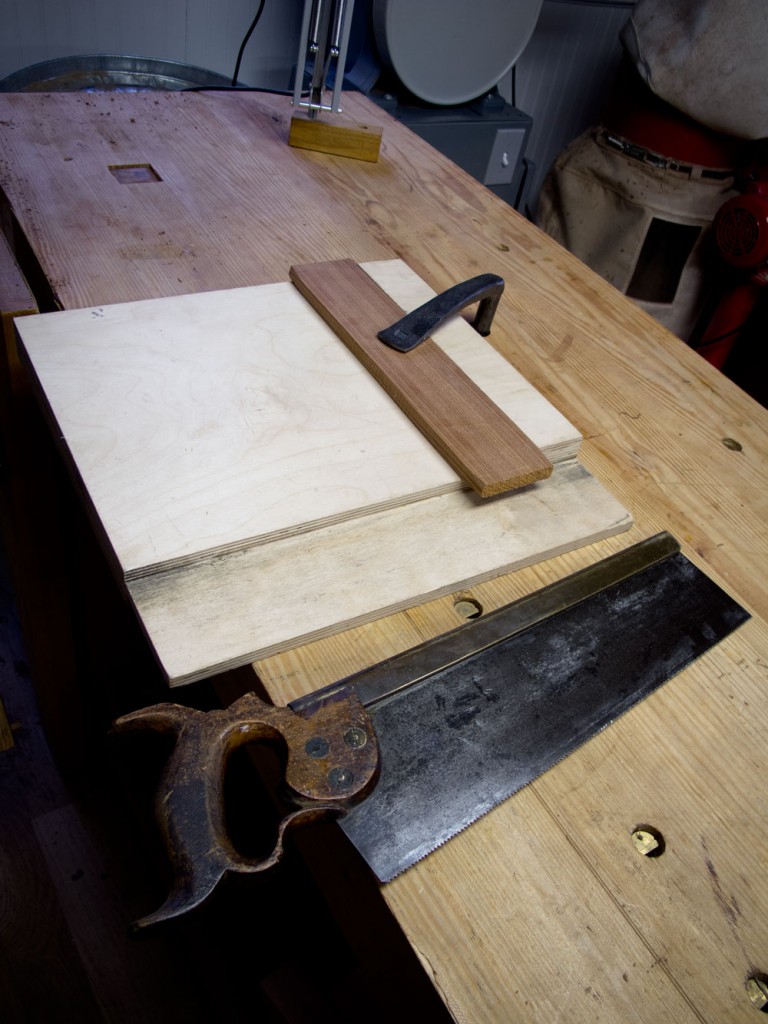We may receive a commission when you use our affiliate links. However, this does not impact our recommendations.
Let me say this first: You are welcome to put a holdfast hole anywhere you please. No one will think less of you. In fact, if you are questioned by your friends as to why you put a certain hole in a certain position, you can tell them it’s a panini press.
That said, I think there’s a method to positioning your holdfast holes. First, take a look at Andre Roubo’s famous plate 11 above, which shows an 18th-century French workshop. The plates from his book, “L’Art Du Menuisier,” are important because Roubo drew them (he is listed as the illustrator on each one) and Roubo was a highly skilled woodworker.
Each bench has small differences, but I see two rows of holes on the benches. One row is near the back and a second (but more irregular) row is slightly closer to the front.
This is the arrangement I followed when I built my first French workbench in 2005.
The row near the woodworker is for joinery. You can see in the plate the woodworkers are using this row to hold their work for mortising, sawing tenon cheeks and sawing tenon shoulders.
For me, the most important hole is up by the face vise and planing stop. This is the hole that works in concert with my bench hook. It allows the pad of the holdfast to press on my work in the bench hook. Though Roubo doesn’t show a bench hook, it’s the same idea: Hold the work so you can conveniently saw it.
The second row of holes isn’t shown in use in Plate 11. But if you bore these holes you’ll decode the reason they are there. They are used (among other things) to secure battens – thin strips of wood. The battens allow you to restrain your work for planing – especially traversing. Plus they are great for holding down sticking boards for making mouldings and shooting boards for truing up long edges of boards.

On my 8’-long bench I have four holes in a row along the back edge of the bench. They are 3-1/2” from the rear edge of the benchtop. The first hole is in line with my face vise. The remainder are positioned based on the reach of my holdfasts. If you have holdfasts with an 8” reach, you can position the holes on 16” to 18” centers and provide lots of coverage.
I also have a holdfast hole at the back of my bench that holds my swing-arm lamp. And some holes in the legs – which support long boards for edge planing and press them to the front of the bench.
So that’s my reasoning. If you have a different philosophy, feel free to add it in the comments below to help your fellow woodworkers decide if their bench should be holier than thous.
— Christopher Schwarz
Other resources:
• Who would have thought that there is much to write about workbenches? I didn’t. Then I started writing about them and have yet to stop. This blog contains hundreds of posts on benches. Click here to start.
• Oh and I’ve written two books and hosted two DVDs on benches that are available in ShopWoodworking.
Here are some supplies and tools we find essential in our everyday work around the shop. We may receive a commission from sales referred by our links; however, we have carefully selected these products for their usefulness and quality.










Mr. Schwarz,
I have recently completed a Roubo workbench based on your “Build an 18th-Century Workbench”. The bench works great and love the design. I have one problem though. After putting in three coat of the finish you described in the book ( equal parts boils linseed oil, varnish, and paint thinner) my hold fasts will not hold at all. I’ve tried sanding the holes and the hold fast iron and still will not hold. I used the hold fast during the construction phase and prior to the finish being applied and they held good. Do you know how I can overcome this problem?
Thanks,
John – Tennessee
I have an Auriou holdfast with an 18mm diameter (0.7″ or 23/32″, a millimeter shy of 3/4″) post. How much oversize do you usually drill the hole?
Thanks,
– Idiot servant
For those looking for holdfasts contact Scott Stager at Someday Forge (bksmithsps@gmail.com) He’s just starting out, so the price is to be determined, but I’m very happy with them.
bob k.
hi
I brought your book and built a roubo bench its great just as you described in the book.
The reason I’m leaving this is I’m moving to france at some point and while looking at property I saw this very old carpenters bench in what is described as a carpenters shed, it has a leg vice and holdfast the end apears to be shaped ! if you want the picture of it let me know
cheers
mick
Chris –
Lee Valley now has a dog hole bushing that “…accept the 1/2″ diameter post of common desk lamps and magnifiers.” ACK!
http://www.leevalley.com/us/wood/page.aspx?p=70534&cat=51&ap=1
I’m sorry I haven’t read everything you’ve written or filmed on the subject of workbenches. Could you please tell me what the brass thingies hiding in the dog holes are? I’m thinking they’re some kind of stop. Or bottle opener.
Chris,
Are those the new LN holdfasts in your picture? How are they working out? How do they compare to the Grammercy?
Pete
Any suggestions on how best to drill holdfast holes a 4″ thick maple bench top? I have a plunge router and a 3/4″ diameter upcut spiral bit, but it doesn’t come close a 4″ depth.
I’ve been looking for articles on how to do this with no luck.
Thanks in advance.
I haven’t put any holes in my workbench top yet, as I am worried about the top being to thick to work well with a hold fast. It is 5.25-inches thick, as that is what the carpenter shop made for me. It was a cold winter, and their shop was very slow, so they told me if they could use it as a fill in job, they would hand select and glue up the bench top 24-inches wide and 8 feet long, as that was as big as their thickness planer would handle. I am very happy with the bench, and don’t know how heavy it is. Found used old pine timbers to recycle for the legs that were 8-inches square, and reduced them to 6-inches square for my legs. Bought the DVD from Chris Schwarz to use as a guide for making the legs and front leg vise. Any way, to much information, but I would like opinions on holdfasts in this thick of a bench top if any one has any experience. If I don’t get a reply, I will make up a test top, and drill a couple of holes and see how my antique Marples holdfasts work in it.
When I built my first bench in 1988, I was using a record-type holdfast, and so I had to inlet two collars into the benchtop. Decisions, decisions… I placed one so that the pad (not the shaft) landed inline with the shoulder vice screw for holding down tailboards while transferring my pin layout. The other I placed so that the pad fell near the front leg so that when chopping the force would be directly over the leg. Worked out well, but now I have Grammercy holdfasts, so I can drop a hole willy-nilly wherever I need it.
And there is no point trying to cover every last little spot on the bench because a piece of scrap placed on the workpiece before applying the holdfast will extend the reach a bit of the holdfast.
I’m always a bit leary of drilling a bunch of holes in my bench. Starting with a plan like this should make for better placement. Would hate to have a Swiss cheese bench 🙂
I put a row of dog holes on my bench spaced about 2 inches in. I did this thinking that I would use a wonder dog like a tail vice, and perhaps one day put on a proper tail vice. In reality I really needed a planing stop instead of those holes. I didn’t see that row of holes so close to the edge in the roubo plate. Roubo seems to place them in such a way that the holdfasts would reach the edge of the bench at their limit. And some are placed even further back to hold things down in the middle of the bench. So I really didn’t need “dog holes.” I tried using them as a planing stop but they kinda suck for that purpose without a tail vice. The more I learn, the more I wish I didn’t put them there.
I’ve been working on my bench for close to a year now , and I still haven’t added all my holdfast holes. I only recently placed two more that are deeper into the bench. These are placed more like where roubo puts them, where the farthest reach of the holdfast is on the edge of the bench. These are more useful. One is situated so that the pad of one holdfast can be placed over the front leg where my leg vice is installed. I imaging this may be useful if I continue to cut joinery with that vice. I plan to build the twin screw vice soon for joinery.
So that’s what i’ve learned. Hope that helps someone.
Instead of plain holes for holdfasts, has anyone added threaded holes for wooden screws?
I’ve been contemplating adding these in lieu of or in addition to holdfasts. I’m envisioning an arm through which the screw passes like the chop of a vice and using it and the screw to clamp the work to the bench top.
Placement would be similar to what you describe for holdfast holes.